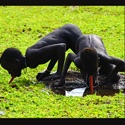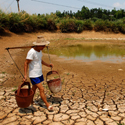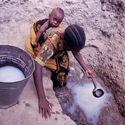Etheopia
In rural Ethiopia, women and children walk up to six hours to collect water. Most people collect water from shallow, unprotected ponds which they share with animals. Other people collect water from shallow wells. Both of these sources are subject to contamination as rain water washes waste from surrounding areas into the source. The jugs women use to carry water back to the village weigh up to 40 pounds! Often, young children are left at home while their mother and older siblings collect water and their fathers work.
In the last 20 years, Ethiopia has experienced recurring droughts followed by food shortages and famines. During times of drought, water-related diseases are rampant. Surface water sources such as springs and ponds dry up. Remaining water sources are heavily contaminated by environmental waste, such as human and animal excreta, which is washed in when it does rain. The stagnant water serves as a breeding place for mosquitoes.
In times of drought, there is often not enough water available for people to bathe regularly. As a result, community members, especially children, suffer from scabies and eye infections. During these times, in an effort to conserve water, hand-washing after defecation or before eating is rarely practiced. Diarrheal and water-related diseases are among the principle causes of death in young children.
Share and Enjoy:




